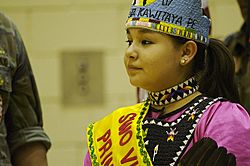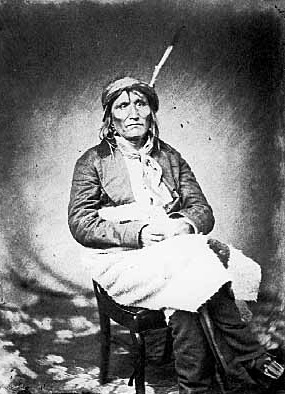Sisseton Wahpeton Oyate facts for kids
|
2006–2007 Sisseton Wahpeton Oyate Vietnam Veterans princess at the University of Minnesota, Morris powwow, photo by Nic McPhee
|
|
| Total population | |
|---|---|
| 12,300 | |
| Regions with significant populations | |
| Languages | |
| English, Dakota | |
| Religion | |
| traditional tribal religion, Christianity, Sun Dance, Native American Church | |
| Related ethnic groups | |
| other Dakota, Lakota, Nakota |
The Sisseton Wahpeton Oyate are a group of Native American people. They are also known as the Sisseton-Wahpeton Sioux Tribe or Dakota Nation. This tribe is made up of two main groups of the Santee Dakota. They live on the Lake Traverse Indian Reservation in South Dakota.
Contents
About the Lake Traverse Reservation
The Lake Traverse Indian Reservation was created by a special agreement. This agreement was called the Lake Traverse Treaty of 1867. From 1884 to 1913, the tribe's government was run by a group called the Soldier's Lodge.
Later, outside groups like government agents and missionaries caused changes. In 1913, the tribe formed an advisory committee. This committee helped lead the tribe until 1946.
In 1934, the U.S. government suggested a new law. It was called the Indian Reorganization Act. By 1946, the tribe had set up a new government system. They created bylaws and elected their own leaders. This new government was based in Agency Village, South Dakota. The tribe became known as the Sisseton Wahpeton Sioux Tribe. They had their own self-government again, based on the 1867 treaty.
From 1946 to 2002, the tribe was called the Sisseton Wahpeton Sioux Tribe. In 1994, they briefly used the name Sisseton-Wahpeton Dakota Nation. Then, in 2002, they voted to change their name. They became the Sisseton Wahpeton Oyate. In the Dakota language, "Oyate" means "people" or "nation."
Tribe Members and Districts
Today, about 12,000 people are members of the tribe. They live in seven different areas across the reservation. In 2004, about 9,894 members lived on the reservation itself.
The tribe's districts are:
- Agency Village or A-te-ya-pi-o-ti-tan-ni
- Lake Traverse or Bde-hda-kin-yan
- Buffalo Lake or Can-o-wa-na-sa-pi
- Veblen or He-i-pa
- Big Coulee or I-ya-ka-pta-pi
- Long Hollow or Ka-ksi-za-han-ska
- Enemy Swim or To-ka-ni-we-ya-pi
The Treaty of 1851
On July 23, 1851, a major agreement was made. It was called the Treaty of Traverse des Sioux. This treaty was between the United States government and the Dakota Sioux people. U.S. officials wanted to gain control of rich farming lands in Minnesota.
The Sioux agreed to give up large areas of land. This land stretched from Iowa north to the Canadian border. Some groups, like the Sisseton and Wahpeton, did not want to give up so much. But they felt they had to agree.
The treaty promised the Dakota people money and supplies. It also set up reservations for them. One was near Granite Falls, Minnesota. Another was near Redwood Falls, Minnesota. The Upper Sioux liked their new land because it had their old villages. It was also good for hunting and fishing. But the Lower Agency land was not good for many Sioux. It forced them to leave their traditional forest homes.
Later, the government added a special rule. It said that some of the money would go to traders. These traders had claims against the Native Americans.
By 1858, Dakota leaders signed two more treaties. They gave up more land north of the Minnesota River. White settlers kept moving in. The government wanted more land. It also failed to pay all the promised money. These issues, along with pressure to change their ways, led to conflict. The loss of hunting and fishing lands also caused great unhappiness. All these problems led to the American Indian Wars. These wars lasted for about 30 years.
The Dakota War of 1862
In August 1862, problems between the Santee Dakota and settlers grew. This led to fighting. It is known as the Dakota War of 1862. On August 4, 1862, the Sisseton and Wahpeton groups received food and supplies. But on August 17, two other groups, the Mdewakanton and Wahpekute, were refused. The U.S. Indian Agent would not give them supplies. He said he had not received payment from the Sioux.
At a meeting, Dakota leaders asked a trader for help. His answer was very insulting. This made the Dakota people very angry. Money for the Dakota arrived in Saint Paul, Minnesota on August 16. It was sent to Fort Ridgely on August 17. But by then, it was too late.
Historians say the fighting began with four Dakota warriors. They were in a settlement in Acton Township, Meeker County, Minnesota. A young warrior reportedly took some eggs. This led to a fight where five white men died. Soon, violence broke out in other areas. The Dakota won some early battles. They had victories at the Battle of Redwood Ferry and the Battle of Birch Coulee. They also attacked New Ulm, Minnesota.
It is important to know that the Sisseton-Wahpeton groups did not take part in killing settler families. Most of the 4,000 members of these two northern tribes did not want to fight. Many Sissetons and Wahpetons had become farmers and Christians. They believed it was wrong to fight. They also had good reasons to keep peace with the white settlers.
Dakota warriors surrounded Fort Abercrombie for six weeks. They stopped supplies and messages from getting through. The large-scale fighting ended on September 26, 1862. Six companies of Minnesota soldiers attacked Dakota positions. This was at the Battle of Wood Lake. Three days later, Dakota forces gave up at Camp Release. They released 269 prisoners.
After the war, the Dakota faced harsh consequences. A U.S. military court found 303 men guilty. They were sentenced to death. The Army hanged 38 men the day after Christmas. This was the largest mass execution in U.S. history. Efforts were made to cancel treaties and remove all Dakota people from Minnesota. Rewards were offered for finding any Dakota person in the area. Only 208 Mdewakanton families were allowed to stay. Soon after, more conflicts broke out. These were part of the American Indian Wars. The wars finally ended with the Wounded Knee Massacre in 1890.
In 1866, the United States Department of War chose Gabriel Renville as the head chief. He was chief scout for General Sibley. In 1867, the Sissetowan band made him Chief for life.
Notable Members of the Tribe

Many important people are part of the Sisseton Wahpeton Oyate:
- Bryan Akipa is a talented Native American flute player.
- Angelique EagleWoman was the first Indigenous Dean of a Canadian law school. She is also an author and law professor.
- Woodrow W. Keeble (1917–1982) was a veteran and received the Medal of Honor. This is a very high award for bravery.
- Gabriel Renville was a nephew of Chief Red Iron. He was the last chief of the Sisseton and Wahpeton groups.
- Creighton Leland Robertson (1944–2014) was an Episcopalian bishop and a lawyer.
- Tamara St. John is the tribal archivist. She is also a Republican member of the South Dakota House of Representatives.
- Kim TallBear is a professor at the University of Alberta. She studies racial politics in science.
- Floyd Red Crow Westerman (1936–2007) was a Sisseton Dakota singer and actor. He was from the Lake Traverse Reservation.
Education for Tribal Members
In 1904, the U.S. government approved a special school. It was an inter-tribal boarding school called the Wahpeton Indian School. It opened in 1908 in Wahpeton, North Dakota. This school was run by the Bureau of Indian Affairs. It was one of the last government boarding schools to open and to operate.
In 1993, the Sisseton Wahpeton Oyate took control of the school. This was almost 20 years after tribes started taking back control of their children's education. The Lake Traverse Reservation reaches into North Dakota.
Since the 1970s, many tribes have educated their children on their own reservations. But this school still helps students who need boarding placement. It was renamed the Circle of Nations Wahpeton School. The Bureau of Indian Education (BIE) funds it. It serves students in grades 4-8.
In 1979, the tribe started its own tribal college. It is called Sisseton Wahpeton College. It is located on the Lake Traverse Reservation. This college now serves about 250 students. More than 80% of them are Dakota. The college first focused on technical and job training. Now, it also offers associate degrees in academic subjects. Students can transfer to four-year colleges to finish their bachelor's degrees. The college started Dakota Studies in 1992. It added a Dakota language program in 2005.



